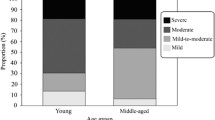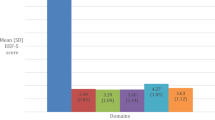Abstract
The Sexual Health Inventory for Men (SHIM) is an effective way to assess erectile difficulty (ED). Despite documented efficacy, however, many physicians may be reluctant to incorporate it into clinical practice because of the intimate nature of the questionnaire. In an attempt to devise and test an easy-to-use computer-based SHIM score indicator for office use, more than 30,000 SHIM questionnaires were administered to men visiting physicians’ offices in 2000. Information about age, current smoking status, diabetes, depression, hypertension, prostate disease, and cholesterol levels was also collected. A logistic regression model with a sensitivity of 81.8% and a specificity of 57.7% was created to predict the likelihood of ED in a patient scoring below 21 (SHIM definition). This model was built into a highly graphic Windows®-based program. The SHIM score indicator is a convenient way to rapidly identify patients at high risk for ED who should be further assessed.
Similar content being viewed by others
References
Feldman HA, Goldstein I, Hatzichristou DG, Krane RJ, McKinlay JB. Impotence and its medical and psychosocial correlates: results of the Massachusetts Male Aging Study.J Urol. 1994;151:54–61.
Johannes CB, Araujo AB, Feldman HA, Derby CA, Kleinman KP, McKinlay JB. Incidence of erectile dysfunction in men 40 to 69 years old: longitudinal results from the Massachusetts Male Aging Study.J Urol. 2000;163:460–463.
NIH Consensus Development Panel on Impotence. Impotence.JAMA. 1993;270:83–90.
Burnett AL. Erectile dysfunction: a practical approach for primary care.Geriatrics. 1998;53:34–48.
Marwick C. Survey says patients expect little physician help on sex.JAMA. 1999;281:2173–2174.
Feldman HA, Johannes CB, Derby CA, et al. Erectile dysfunction and coronary risk factors: prospective results from the Massachusetts Male Aging Study.Prev Med. 2000;30:328–338.
Sullivan ME, Thompson CS, Dashwood MR, et al. Nitric oxide and penile erection: is erectile dysfunction another manifestation of vascular disease?Cardiovasc Res. 1999;43:658–665.
Lochmann A, Gallmetzer J. Erectile dysfunction of arterial origin as possible primary manifestation of atherosclerosis [in Italian].Minerva Cardioangiol. 1996;44:243–246.
Korenman SG. New insights into erectile dysfunction: a practical approach.Am J Med. 1998; 105:135–144.
Zesiewicz TA, Helal M, Hauser RA. Sildenafil citrate (Viagra) for the treatment of erectile dysfunction in men with Parkinson’s disease.Mov Disord. 2000;15:305–308.
Chew KK, Earle CM, Stuckey BG, Jamrozik K, Keogh EJ. Erectile dysfunction in general medicine practice: prevalence and clinical correlates.Int J Impot Res. 2000;12:41–45.
Burchardt M, Burchardt T, Baer L, et al. Hypertension is associated with severe erectile dysfunction.J Urol. 2000;164:1188–1191.
Roose SP, Seidman SN. Sexual activity and cardiac risk: is depression a contributing factor?Am J Cardiol. 2000;86(suppl 2A):38F-40F.
Shabsigh R, Klein LT, Seidman S, Kaplan SA, Lehrhoff BJ, Ritter JS. Increased incidence of depressive symptoms in men with erectile dysfunction.Urology. 1998;52:848–852.
Seidman SN, Roose SP. The relationship between depression and erectile dysfunction.Curr Psychiatry Rep. 2000;2:201–205.
Goldstein I. The mutually reinforcing triad of depressive symptoms, cardiovascular disease, and erectile dysfunction.Am J Cardiol. 2000;86(suppl 2A):41F-45F.
Sadovsky R. Integrating erectile dysfunction treatment into primary care practice.Am J Med. 2000;109(suppl 9A):22S-28S.
Manecke RG, Mulhall JP. Medical treatment of erectile dysfunction.Ann Med. 1999;31:388–398.
Author information
Authors and Affiliations
Rights and permissions
About this article
Cite this article
Day, D., Ambegaonkar, A., Harriot, K. et al. A new tool for predicting erectile dysfunction. Adv Therapy 18, 131–139 (2001). https://doi.org/10.1007/BF02850301
Issue Date:
DOI: https://doi.org/10.1007/BF02850301




